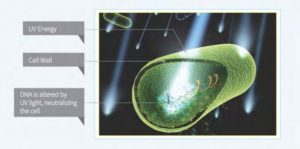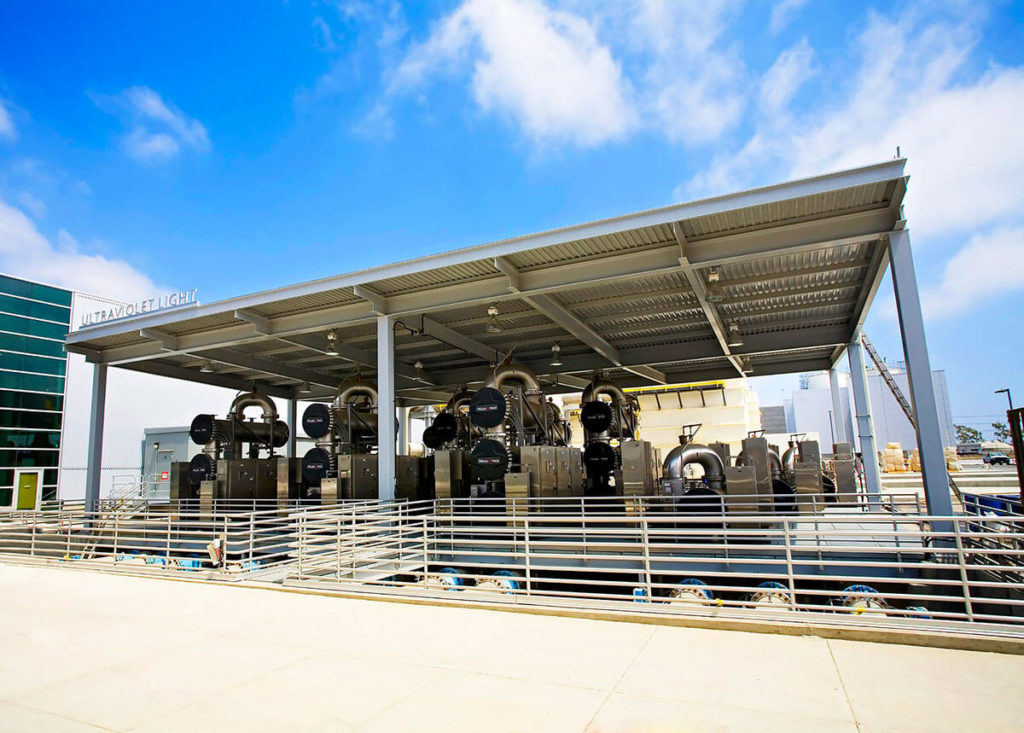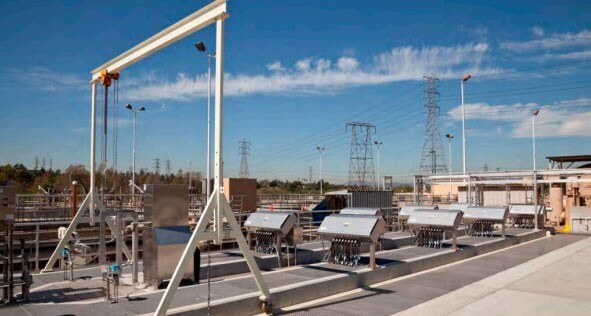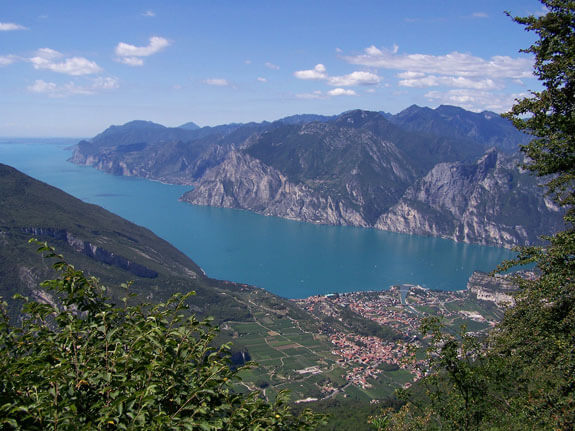Answering Your Water Reuse Questions
UV and Water Reuse Treatment
These days, utilities are facing constant pressure to protect workers and the public from chemical hazards, while reducing costs and increasingly sustainability. How to do this though? Here are our answers to many of the frequently asked questions we hear about water reuse and UV treatment.
1. How do ultraviolet (UV) treatment systems work to reduce microorganisms?
UV treatment is a physical process whereby ultraviolet lamps emit UV-C energy into the wastewater to directly inactivate microorganisms. The UV light penetrates the cell wall of the microorganism and is absorbed by the microorganism’s DNA. Upon absorption, the DNA strand (and microorganism) is damaged and unable to replicate or cause an infection. UV light alters the DNA of microorganisms, so they can no longer reproduce or infect those coming into contact with the water.
2. How does UV compare with other treatment methods for reuse, such as chlorine gas or sodium hypochlorite?
As water demands increase and supplies decrease, reuse of treated wastewater is becoming more important. There are a few key differences between UV inactivation and chemical methods. UV does not add anything to the water except light. As such, there is no balancing act between dosing and residuals, so there is no risk of exceeding THM (trihalomethanes) limits or chlorine residual requirements.

The UV inactivation process takes place in seconds, so the footprint required for treatment is significantly smaller with UV. Large concrete contact basins are not required; UV systems are installed in a pipe network or in an open flow-through channel.
3. How can UV treatment systems be utilized for IPR?
Indirect potable reuse (IPR) projects are getting more attention lately. TrojanUV systems have been used for IPR for a number of years, producing recycled water suitable for groundwater recharge, aquifer augmentation, and seawater intrusion prevention.

The Orange County Water District’s world-renowned Groundwater Replenishment System uses hydrogen peroxide as the oxidant for their UV advanced oxidation process (UV AOP).
UV inactivation augmented with an oxidation process (UV-oxidation) targets environmental and chemical contaminants that are not removed by upstream treatment processes. Nitrosodimethylamine (NDMA), for example, is a carcinogenic compound commonly found in wastewater that can pass through microfiltration and reverse osmosis processes but is broken down by UV.
4. Can UV help to reduce other contaminants?
Yes, the UV-photolysis/UV-oxidation processes target and break down harmful contaminants such as 1,4-dioxane, nitrosamines (e.g. NDMA), pesticides and herbicides, and contaminants of emerging concern such as endocrine-disruptor chemicals and pharmaceuticals and personal care products.

UV light in combination with hydrogen peroxide creates hydroxyl radicals that break the bonds of chemical contaminants, reducing them to their elemental components.
5. How can energy usage for UV treatment be optimized?
UV system efficiency is a function of the UV lamp characteristics as well as the overall chamber design (e.g., lamp spacing, placement, inlet/outlet). After selecting the appropriate lamp, Trojan’s engineers optimize the chamber design using sophisticated modeling software including computational fluid dynamics. Real-world bioassay testing is subsequently completed to ensure field results match theoretical predictions.
Utilities are always pressured to save costs and improve sustainability – an optimized and validated UV system helps save money by using only the power and lamps needed to meet specific treatment objectives. UV is considered a sustainable treatment technology since it doesn’t use chemicals and has a small physical footprint and reduced construction effort compared to the alternatives.
6. What are typical maintenance requirements for UV treatment systems?
For proper performance, it is critical to ensure that UV lamps are emitting the right amount of light and that the light is reaching the microorganisms. As such, typical maintenance activities will include checking intensity sensor calibration, replacing aged lamps, and ensuring that quartz sleeves housing the lamps are clean. A daily inspection for alarms and general system performance and cleanliness is also recommended.
7. Are there options for using UV treatment without breaking head in the process?
Absolutely. This is a common request from facilities that use pressurized membranes upstream of UV and virtually all IPR and DPR (direct potable reuse) applications. UV systems configured in a closed chamber for installation in a pipe network are designed for those applications.
8. How does a UV system accommodate the fluctuating flow levels at water reclamation plants?
UV systems are designed for flexible operation, both in terms of the control system and the equipment itself. TrojanUV systems use variable output lamp drivers, so lamp intensity automatically ramps down when flow rates drop in order to save power and money. In addition, entire units and trains of equipment will shut on/off in response to flow rates (and water quality) to optimize the amount of equipment in use. Lastly, in open-channel systems, level control devices are key to ensuring that lamps are submerged at the appropriate depth at all times.
9. What size facility is UV reuse most appropriate?
For municipal reuse applications, the size of the facility is not a limiting factor. UV has been applied to very small plants, such as those found in a development/gated community, up to large municipal plants treating more than 100 million gallons per day. Each must be carefully sized and planned, but the technology exists to enable plants of virtually any size to recycle and reuse their wastewater.
10. How can UV technology be retrofitted into an existing reclaimed water plant?
UV is often added to an existing reclaimed water plant when the municipality decides to move away from chlorine and its operational challenges. The Whittier Narrows Water Reclamation Plant in Los Angeles County did just that in 2008. They converted their inactivation process from sodium hypochlorite to UV technology and are using 100% of the recycled water within the facility at Upper San Gabriel Valley Water District and for groundwater recharge.

The Whittier Narrows Water Reclamation Plant in Los Angeles County converted their treatment process from sodium hypochlorite to UV.
When incorporating UV into an existing facility, it is important to look at the hydraulic profile, water quality, available space, and power/control systems. It is very rare that a UV system doesn’t fit into existing chlorine contact tanks. However, some plants decide to build new channels for UV and reserve the chlorine basins for storage or other uses. Trojan engineers are experienced in UV retrofits and work through each of these important design considerations, as each site is different. Our goal is to help municipalities recycle their valuable resource and ensure the reuse water is properly treated and suitable for potable and non-potable uses.
Featured Posts
First Potable Reuse Demo Plant in Europe uses Trojan UV AOP
Trojan is proudly part of the Consorci d'Aigües Costa Brava Girona’s AIGUANEIX water purification project Trojan Technologies is excited to share that we’re part of Diputació de Girona and Consorci d'Aigües Costa Brava Girona’s AIGUANEIX water reuse pilot project at...
Trojan Technologies Opens First U.S. Distribution Facility in Grand Rapids, Michigan
On March 3, 2025, Trojan Technologies celebrated the grand opening of its first U.S. distribution center in Grand Rapids, Michigan. This strategic expansion underscores the company's dedication to enhancing customer experience and optimizing the delivery of its...
Veralto Enters Agreement to Purchase AQUAFIDES
WALTHAM, Mass., Feb. 17, 2025 /PRNewswire/ -- Veralto Corporation (NYSE: VLTO) (the "Company"), a global leader in essential water and product quality solutions dedicated to Safeguarding the World's Most Vital Resources™, announced the signing of a definitive...







